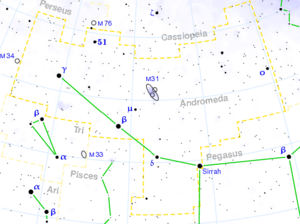Andromeda (constellation)
 Click for larger image |
|
| List of stars in Andromeda | |
| Abbreviation: | And |
| Genitive: | Andromedae |
| Symbolism: | Andromeda, the Chained Maiden |
| Right ascension: | 1 h |
| Declination: | +40° |
| Area: | 722 sq. deg. (19th) |
| Main stars: | 4, 18 |
| Bayer/Flamsteed stars: |
65 |
| Stars with known planets: |
4 |
| Bright stars: | 3 |
| Nearby stars: | 5 |
| Brightest star: | α And (Alpheratz) (2.1m) |
| Nearest star: | Ross 248 (10.32 ly) |
| Messier objects: | 3 |
| Meteor showers: | Andromedids (Bielids) |
| Bordering constellations: |
Perseus Cassiopeia Lacerta Pegasus Pisces Triangulum |
| Visible at latitudes between +90° and −40° Best visible at 21:00 (9 p.m.) during the month of November |
|
Andromeda (pronounced /ænˈdrɒmɨdə/) is a constellation in the northern sky. It is named after the princess Andromeda in Greek mythology and is bordered by Cassiopeia, Lacerta, Pegasus, Pisces, Triangulum and Perseus. It is most notable for containing the Andromeda Galaxy. It is sometimes called "The Chained Maiden" in English, as the mythological Andromeda was chained to a rock before being rescued by Perseus.
Contents |
Notable features
Stars
The brightest star in the constellation is α Andromedae, also known by its traditional names of Alpheratz and Sirrah. α Andromedae is a binary star with an overall apparent visual magnitude of 2.06.
β Andromedae is named Mirach, the girdle. It is 200 light years distant and of magnitude 2.1.
γ Andromedae, or Almach, is found at the tip of the southern leg of the big "A". It is a multiple star with contrasting colors.
υ Andromedae has a planetary system with three confirmed planets, 0.71 times, 2.11 times, and 4.61 times the mass of Jupiter.
Additional Named Stars in Andromeda
| Bayer | Name | Origin | Meaning |
|---|---|---|---|
| ζ And | Adhil | Arabic | train of a garment |
| φ And | Kuen | Chinese | camp |
| χ And | Nan Mun | Chinese | south gate |
Deep sky objects
The most famous deep sky object in Andromeda is M31, the Andromeda Galaxy, one of the most distant objects visible to the naked eye (M33, the Triangulum Galaxy, is slightly farther). It is an enormous spiral galaxy much like the Milky Way. To find the galaxy, draw a line between β and μ Andromedae, and extend the line approximately the same distance again from μ.
Illustrations
When the constellation is envisaged as representing the princess Andromeda, α Andromedae is normally considered to marks her head. However, the star's traditional names mean "navel of the horse", and it was formerly considered common to both Andromeda and Pegasus (and designated δ Pegasi), since it forms an asterism with α, β, and γ Pegasi known as the Great Square of Pegasus.
When the fainter stars, visible to the naked eye, are considered alongside α Andromedae, then the constellation can be interpreted as a stick-figure woman with a prominent belt, and an arm with something long attached to it, giving the appearance of a female warrior holding a sword. This, together with other stars in the zodiac sign of Aries (part of Pisces, and the Pleiades), may be the origin of the myth of the girdle of Hippolyte, which forms part of The Twelve Labours of Hercules.
However, when still fainter stars are included, the attachment extends in a different direction, giving the appearance of a maiden held by a chain. Together with other constellations nearby (Cassiopeia, Cepheus, Cetus, Pegasus, and Perseus), this may be the source of the myth of the Boast of Cassiopeia, with which it is usually identified.
In other cultures
In the Chinese constellations, the stars of Andromeda are instead included in the asterisms of the Flying Serpent (in the constellation of the Encampment), Celestial Stable (in the mansion of the Wall), Southern Military Gate (in the mansion of the Legs), and Great General of the Heaven (in the mansion of the Bond).
See also
- List of stars in Andromeda
- Andromedids meteor shower
References
- Ian Ridpath and Wil Tirion (2007). Stars and Planets Guide, Collins, London. ISBN 978-0007251209. Princeton University Press, Princeton. ISBN 978-0691135564.
- H. A. Rey, The Stars — A New Way To See Them. Enlarged World-Wide Edition. Houghton Mifflin, Boston, 1997. ISBN 0-395-24830-2.
External links
- The Deep Photographic Guide to the Constellations: Andromeda
- NightSkyInfo.com: Constellation Andromeda
- WIKISKY.ORG: Andromeda
- Star Tales – Andromeda
|
|||||
|
||||||||||||||||||||||||||||||||